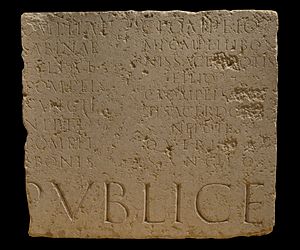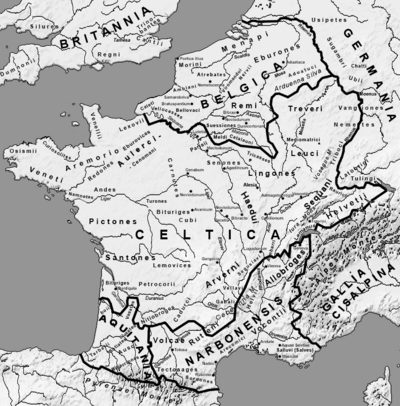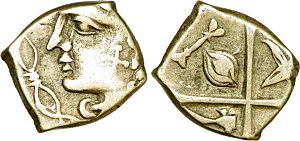Petrocorii facts for kids
The Petrocorii were an ancient Gallic tribe. They lived in what is now the Périgord region of France. This area is located between the Dordogne and Vézère rivers. The Petrocorii lived there during the Iron Age and the Roman period.
Contents
What Does Their Name Mean?
The name Petrocorii comes from two old Gallic words. Petru- means 'four' and corios means 'army' or 'troops'. So, their name means 'four armies'.
Ancient writers like Julius Caesar, Strabo, and Pliny the Elder mentioned them. They used slightly different spellings, like Petrocoriis or Petrokórioi.
Many Gallic tribes used numbers in their names. For example, the Tricorii meant 'three armies'. The name 'four armies' might mean that the Petrocorii tribe was formed when four smaller groups joined together.
The modern city of Périgueux and the Périgord region are named after this ancient tribe. For instance, around 400 AD, Périgueux was called civitas Petrocoriorum, meaning 'city of the Petrocorii'.
Where Did the Petrocorii Live?
The Petrocorii lived in the area we now call the Périgord region. This land is found between the Dordogne and Vézère rivers in France.
Their territory was surrounded by other tribes:
- To the north: the Lemovices and Santones
- To the east: the Arverni
- To the west: the Bituriges Vivisci
- To the south: the Nitiobroges and Cadurci
During the Roman period, their main town was Vesunna. Today, this town is known as Périgueux.
History of the Petrocorii

In 52 BC, the Petrocorii played a part in a major historical event. They sent about 5,000 warriors to join Vercingetorix. He was a Gallic leader who was fighting against the Roman legions led by Julius Caesar.
The ancient writer Strabo also wrote about the Petrocorii. He noted that they were very skilled at working with iron. This suggests they were good metalworkers.
See also
 In Spanish: Petrocorios para niños
In Spanish: Petrocorios para niños




